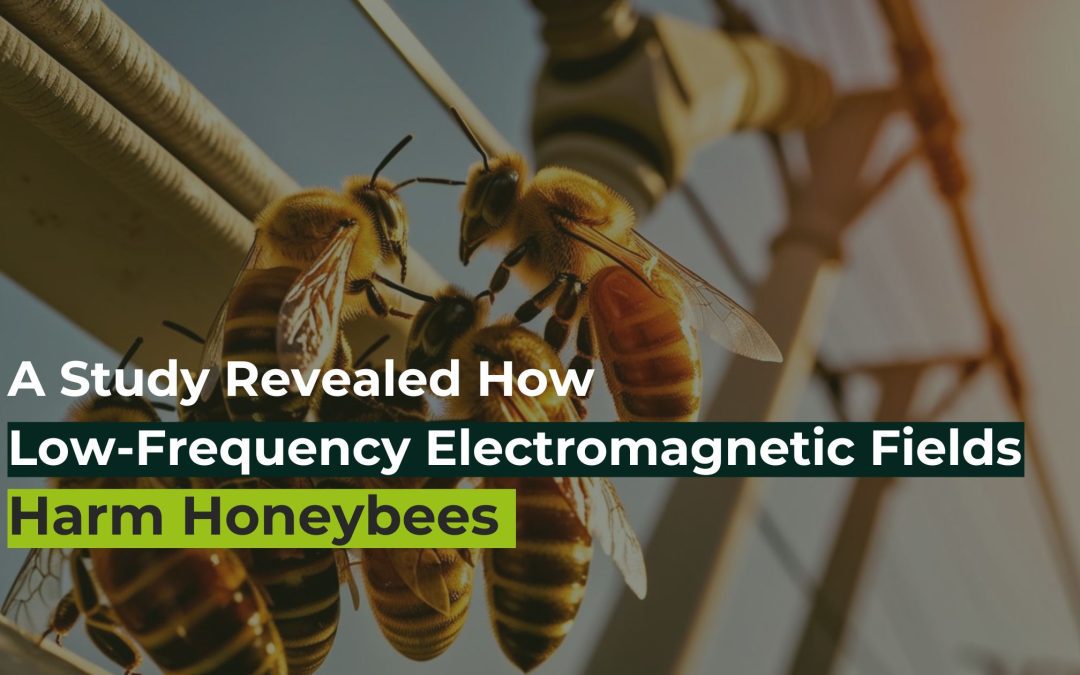A landmark study titled “Extremely Low Frequency Electromagnetic Fields impair the Cognitive and Motor Abilities of Honey Bees” published in Nature Scientific Reports in 2018 found alarming evidence about the impact of electromagnetic fields (EMFs) on honey bees.
The research, conducted in the UK by Shepherd and colleagues, demonstrated that exposure to extremely low frequency electromagnetic fields (ELF EMFs)—commonly emitted by power lines and electrical infrastructure—significantly impairs bees’ cognitive and motor abilities, with potential devastating consequences for pollination and food security worldwide.
The Critical Importance of Bees
Honey bees contribute approximately 80% of insect pollination globally, making them essential to agricultural production and ecosystem health. Their role in pollinating roughly 75% of the world’s food crops places them at the center of our food security system. With bee populations already under threat from multiple stressors including parasites, pesticides, and climate change, this identified risk factor demands urgent attention.
The study, now seven years old, was published at a critical time as bee colonies were experiencing alarming declines. While much attention has focused on neonicotinoid pesticides and habitat loss, the role of electromagnetic pollution was largely overlooked—and continues to be underexamined today.
Methodology and Key Findings
The researchers from the University of Southampton conducted a series of carefully controlled experiments to assess how ELF EMFs at different intensities affect honey bee learning, flight, foraging, and feeding behaviors. They tested bees at exposure levels ranging from 20-100μT (found at ground level beneath power lines) to 1000-7000μT (found within 1 meter of electrical conductors).
The results were striking and consistent across multiple experimental setups. As the authors directly state in their paper: “ELF EMF exposure was found to reduce learning, alter flight dynamics, reduce the success of foraging flights towards food sources, and feeding.”
Impaired Learning and Memory
Bees exposed to EMFs showed significantly reduced olfactory learning abilities in proboscis extension response (PER) tests. While control bees achieved a 73% learning acquisition rate, those exposed to increasing levels of EMFs showed progressively worse performance:
- 20μT exposure: 63% learning acquisition
- 100μT exposure: 42% learning acquisition
- 1000μT exposure: just 36% learning acquisition
This dramatic reduction in cognitive function has serious implications for bees’ ability to remember and locate food sources—a fundamental requirement for successful foraging and pollination.
Altered Flight Dynamics
When exposed to EMFs during tethered flight, bees showed immediate physiological responses. The researchers recorded significant increases in wingbeat frequency that correlated with the intensity of the EMF exposure. Higher EMF levels (1000μT and 7000μT) caused the most pronounced changes in flight behavior, suggesting that proximity to high-voltage lines could significantly affect bee flight mechanics.
Reduced Foraging Success and Feeding
Perhaps most concerning were the findings from real-world foraging scenarios. Bees exposed to 100μT EMFs—a level commonly found at ground level near power lines—showed a 6.6% reduction in successful outgoing foraging flights and an 11.6% increase in failed attempts to reach food sources. Additionally, EMF exposure significantly reduced the number of bees feeding over time compared to control conditions.
Environmental Implications
The geographical reach of this problem is staggering. In the UK alone, the study authors noted that the 22,643km of high-voltage power lines create potential EMF exposure zones covering nearly 30% of the land where bees forage. When including lower voltage distribution lines (over 279,000km in the UK), the potential area of impact expands dramatically.
The researchers concluded that “50Hz ELF EMFs emitted from powerlines may represent a prominent environmental stressor for honey bees, with the potential to impact on their cognitive and motor abilities, which could, in turn, reduce their ability to pollinate crops.”
Beyond Honey Bees: Ecosystem Effects
While this study focused specifically on honey bees, the findings raise serious questions about the effects of EMFs on other pollinators and insects. Research has documented alarming declines in insect biomass worldwide, with one study reporting a more than 75% decrease over 27 years in protected areas. The role of electromagnetic pollution in this broader insect crisis warrants urgent investigation.
The EFEIA Foundation’s Apiary Protection Project represents an important step toward addressing this issue. This initiative focuses on safeguarding bee populations from the harmful effects of electromagnetic fields through research, practical solutions, education, and innovative protection technologies.
Protective Measures and Solutions
The study highlights the need for multifaceted approaches to mitigate EMF exposure in bees:
- Strategic hive placement: Keeping apiaries at safe distances from power lines and electrical infrastructure.
- EMF mitigation technologies: Implementing comprehensive EMF filtration systems that prioritize the reduction of harmful electromagnetic frequencies. Depolarizers such as SPIRO (Spin Radiation Organizer) technology and harmonizers could help balance the space, creating electromagnetically hygienic environments for bee colonies.
- Policy changes: Developing new standards for power line placement that consider impacts on pollinators.
- Further research: Investigating long-term effects and potential protective measures.
The NOXTAK Center, in collaboration with EFEIA, has been exploring protective technologies like SPIRO that may help create electromagnetically hygienic environments for bees. Initial results from field applications show promise, but more research is needed to validate these approaches at scale.
A Call for Action
The findings from this study, published in Nature’s Scientific Reports seven years ago, still represent a critical wake-up call for scientists, policymakers, and the public. As we have continued to expand our electrical and wireless infrastructure in the years since, we must consider the unintended consequences for the insects that sustain our food systems and ecosystems.
The EFEIA Foundation invites beekeepers, farmers, researchers, and concerned citizens to join their Apiary Protection Project, which aims to gather data, implement solutions, and advocate for policies that protect bees from electromagnetic pollution. By contributing to this initiative, you can help ensure that these essential pollinators continue to thrive in our increasingly electrified world.
As the authors of the study concluded, “It is clear that we now need to understand the effects of EMFs on pollinator species in general, the mechanisms underlying these cognitive and motor effects, and the ecological implications of EMF pollution in the field, including impacts on ecosystem services that bees and other insects provide.”
The time to act is now, before we reach a tipping point for bee populations that could have cascading effects throughout our food systems and natural environments. By addressing electromagnetic pollution alongside other known stressors, we may still have time to reverse the troubling decline in these vital pollinators.

